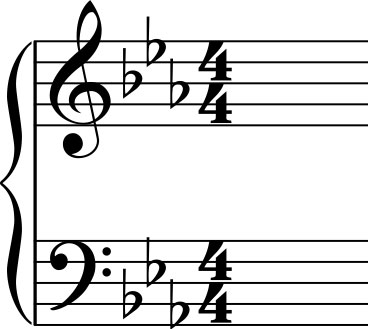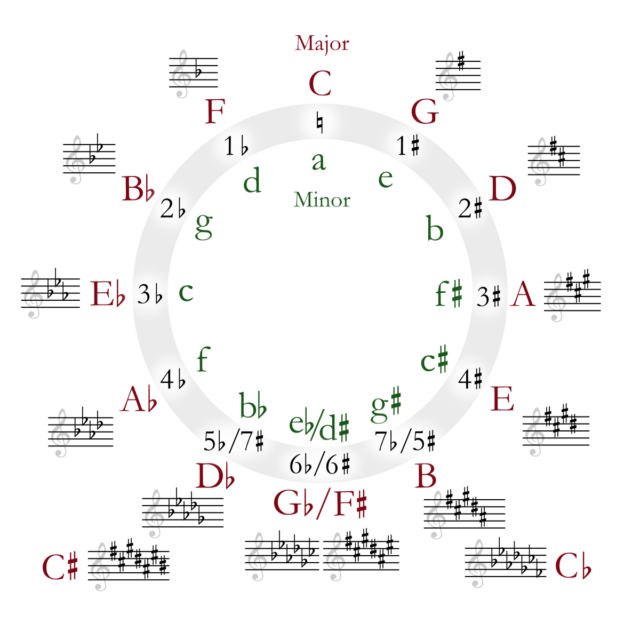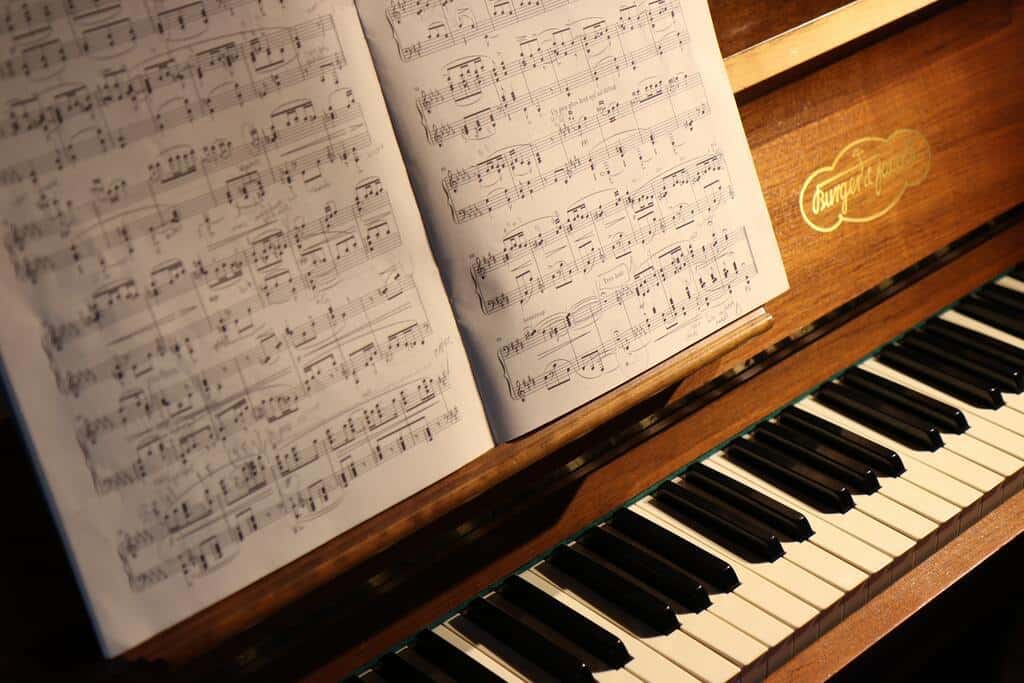When you play a piece of music, at the beginning, you might see a set of sharps or flats. These symbols are more than just markings, they’re key signatures. A key signature reveals not only which notes will be sharp or flat, but also sets the stage for the entire piece by defining its key centre. Whether you want to perform or write music, understanding key signatures is your first step in unlocking a true understanding of the music you play. In this helpful guide we will break down key signatures step by step, shedding light on this important piece of music theory.

The essence of key signatures in musical notation
Key signatures are not just symbols on a page; they are the foundation upon which music is built. In written music, key signatures serve a vital role, informing the musician about the scale and tonality of the piece. Located at the beginning of a piece, the key signature defines which notes will be sharp or flat throughout the song. They reveal the very heart of a composition, giving information on a piece’s key and tonal direction.
Explanation of how key signatures work
When you see a series of sharps (♯) or flats (♭) at the beginning of a staff, you’re looking at the key signature. These sharps or flats apply to specific notes throughout the piece, altering their pitch accordingly. For instance, if a key signature has a sharp on the F line, every F note in the piece is played as F sharp, unless otherwise indicated by a natural sign (♮).

The significance of key signatures for musicians
This system streamlines the notation process, eliminating the need to repeatedly mark sharps or flats on individual notes. It’s a tool that makes reading and playing music more efficient and intuitive. For composers, key signatures are a tool to convey their musical vision, setting the tonal quality and emotional tone of the piece.
Key signatures can influence the entire feel of a piece and a change in key signature can dramatically alter its mood and character, this is known as modulation. Composers choose key signatures based on various factors, including the instrumental or vocal range and desired emotional effect. This choice is a critical part of the creative process, shaping the listener’s emotional response to the music.
Learn how to play ‘Moonlight Sonata’ by Ludwig van Beethoven. Start a 7 day trial today – no card details required!
The mechanics of reading key signatures
Learning how to read key signatures is an essential skill for any musician. Here’s a step-by-step guide to help you navigate this aspect of musical notation:
Identify sharps or flats: Look at the beginning of the staff. The key signature will consist of either sharp (♯) or flat (♭) symbols on certain lines or spaces. These indicate which notes are to be altered throughout the piece.
Order of sharps and flats: Remember that sharps and flats in key signatures always appear in a specific order. For sharps, the order is F♯, C♯, G♯, D♯, A♯, E♯, B♯. For flats, it’s B♭, E♭, A♭, D♭, G♭, C♭, F♭. This order helps in identifying the key. Notice how the order of sharps and flats is opposite. The ‘Father Charles’ mnemonic is commonly used to remember the order of sharps and flats in music. Here’s how it works:
- Order of sharps:
- The mnemonic Father Chares Goes Down And Ends Battle represents the order of sharps as they appear in key signatures: F♯, C♯, G♯, D♯, A♯, E♯, B♯
- Order of flats:
- The reverse of the sharp mnemonic, Battle Ends And Down Goes Charles’ Father, represents the order of flats: B♭, E♭, A♭, D♭, G♭, C♭, F♭
These handy mnemonics help musicians quickly recall which sharps or flats are present in each key signature.
Last sharp or flat rule: A quick way to identify a key signature is memorising these two rules:
- For sharp key signatures, the key is a half step above the last sharp.
- For flat key signatures, the second-to-last flat is the key.
Rules to remember
Here are some essential rules for understanding how to read key signatures:
- Each key signature corresponds to only one major scale.
- The sequence of sharps and flats follows a specific, unchanging order.
- Major scales use either flats or sharps, but never a combination of both.
- When writing key signatures, sharps and flats are placed on specific lines or spaces. For instance, in the treble clef, F# will always be placed on the highest F (F♯5) and not on the lower F (F♯4).
How to use the circle of fifths
The circle of fifths is an invaluable tool for understanding and memorizing key signatures for both writing and reading music. It’s a visual representation that links keys in a way that reveals their relationships to one another.
The circle of fifths arranges keys in a circle, with each key a fifth apart from the next. Starting from C major (with no sharps or flats), each step clockwise adds a sharp, while each step counterclockwise adds a flat. This arrangement not only helps in identifying key signatures but also in understanding the harmonic relationships between different keys.
Using the circle of fifths, you can easily determine the number of sharps or flats in a key signature. For example, moving clockwise from C major, the next key is G major (one sharp), followed by D major (two sharps) and so on. Similarly, moving counterclockwise, F major has one flat, B♭ major has two flats and the pattern continues.

Understanding minor key signatures
Minor key signatures offer a contrast to the major keys signatures, often conveying a sense of melancholy, introspection, or solemnity.
The circle of fifths illustrates relative majors and minors with each minor key being associated with a relative major key, sharing the same key signature but centering on a different tonal base. This relationship is pivotal in music theory.
For instance, A minor is the relative minor of C major and both share no sharps or flats in their key signature. However, the tonal quality and emotional impact of A minor is distinctly different from C major.
Memorization techniques for the circle of fifths
- Visual aids: Use a diagram of the circle of fifths as a reference. Many musicians keep a copy handy for quick consultation.
- Practice progressions: Play chord progressions that move in fifths to get a feel for the circle’s practical application in music.
- Memory recall: Regularly test yourself to see if you can write out the circle of fifths from memory. This can be a handy skill if you don’t have one available when you need it.
- Regular review: Regularly review the circle of fifths, especially when learning new pieces in different keys.
Key signature charts
A key signature chart is a visual aid that can greatly simplify the process of learning and remembering key signatures. It’s a quick reference guide that displays all the major and minor key signatures in an easily digestible format.
For beginners, especially those learning through apps like Skoove, a key signature chart can be an invaluable resource. It aids in the recognition of key signatures and serves as a constant reference during practice sessions. As learners progress, they’ll find themselves consulting the chart less frequently, but its value in the early stages of learning cannot be overstated.
Chart of sharp major scale key signatures
| Key Signature | Sharp Count | Sharps | Minor Key | Equivalent Keys |
|---|---|---|---|---|
| C major | 0 | None | A minor | None |
| G major | 1 | F♯ | E minor | None |
| D major | 2 | F♯ C♯ | B minor | None |
| A major | 3 | F♯ C♯ G♯ | F♯ minor | None |
| E major | 4 | F♯ C♯ G♯ D♯ | C♯ minor | None |
| B major | 5 | F♯ C♯ G♯ D♯ A♯ | G♯ minor | None |
| F♯ major | 6 | F♯ C♯ G♯ D♯ A♯ E♯ | D♯ minor | None |
| C♯ major | 7 | F♯ C♯ G♯ D♯ A♯ E♯ B♯ | A♯ minor | None |
Flat major scale key signatures chart
| Key Signature | Flats Count | Flats | Minor Key | Equivalent Keys |
|---|---|---|---|---|
| C major | 0 | None | A minor | None |
| F major | 1 | B♭ | D minor | None |
| B♭ major | 2 | B♭ E♭ | G minor | None |
| E♭ major | 3 | B♭ E♭ A♭ | C minor | None |
| A♭ major | 4 | B♭ E♭ A♭ D♭ | F minor | None |
| D♭ major | 5 | B♭ E♭ A♭ D♭ G♭ | B♭ minor | C♯ major/A♯ minor |
| G♭ major | 6 | B♭ E♭ A♭ D♭ G♭ C♭ | E♭ minor | F♯ major/D♯ minor |
| C♭ major | 7 | B♭ E♭ A♭ D♭ G♭ C♭ F♭ | A♭ minor | B major/G♯ minor |
Mastering key signatures
Key signatures are far more than technical details in sheet music; they are the gateway to understanding the tonal foundation of music. By mastering key signatures you can gain the ability to sight-read with confidence, transpose and compose with informed musical choices. For those looking to enhance their skills, Skoove offers interactive lessons and tools to help you master key signatures and other essential music theory concepts. Enjoy using and incorporating this interesting musical feature into your playing and writing. Happy practicing!
Author of this blog post:
Susana Pérez Posada

With over seven years of piano education and a deep passion for music therapy, Susana brings a unique blend of expertise to Skoove. A graduate in Music Therapy from SRH Hochschule Heidelberg and an experienced classical pianist from Universidad EAFIT, she infuses her teaching with a holistic approach that transcends traditional piano lessons. Susana’s writings for Skoove combine her rich musical knowledge with engaging storytelling, enriching the learning experience for pianists of all levels. Away from the piano, she loves exploring new places and immersing herself in a good book, believing these diverse experiences enhance her creative teaching style.
Published by Lydia Ogn from the Skoove team














